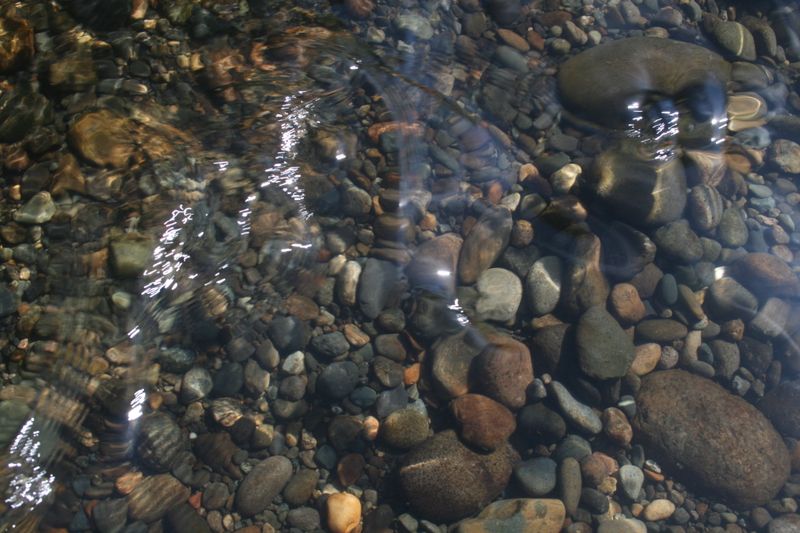
Pond…Gravel, those two words used together can make some peoples hair bristle and teeth grind. Gravel use in constructed ponds is hotly debated with lots of passion behind each side’s opinion. Gravel is certainly an aesthetic choice, but it is also a filtration choice.
Gravel filtration is not a new concept although many treat gravel filtration as though it is new to the scene. Gravel filtration is actually a method that has been used for literally thousands of years as a means to clean and purify water. Even the ancient Sumerians utilized this filtration technology. Water was (is) a precious commodity and when times called for it even the use of water that was knowingly contaminated, stagnated, and filthy would be brought to use, and one of the methods to revitalize this water was by means of gravel filtration. Yes, even the ancients knew that percolating water through layers of gravel would strip sediments, break down impurities, remove odors, and purify the water to the point of usability. I’d imagine to get the water into drinking condition they would have even boiled it and perhaps run it over some old coals (carbon)…sound familiar?
So why, many millennia later, are many of us arguing about the use of gravel as a means of filtration in today’s constructed ponds? Is it not proven the filtration benefits of gravel? Yes, it is proven many times over! I have pondered this for some time and have come to some realizations as to perhaps why people feel they way they do about gravel as choice of filtration in ponds. In a very general way I think most of the problem lies in the word itself “gravel”.
What is gravel? What picture is in your mind when the word gravel is mentioned? What does gravel mean to you? Gravel is highly subjective and usually not defined as to what EXACTLY we mean by gravel. Even now as I talk about gravel some of you envision grit that is used on bird cages, while others picture gravel grains the size of eggs, while others think of the material laid down on highways or country roads. Or the gravel from your living room aquarium, or the white quartz gravel that your neighbor uses around his landscape plants. Are they all gravel? Yes. But I am not talking about any of those types of gravel and most people making arguments for or against gravel as a choice of filtration in ponds never really define what they are arguing for OR against! In my local stone center I have at least 30 or more different types of gravel that I can think of, and only 3 or 4 of those would I consider suitable for use in a pond.
I do a lot of troubleshooting on ponds and I have seen everything from sand installed in a pond to gravel that has a 2”-3” grain size (huge!). I’ve seen construction gravel used, and I’ve come across crushed lava rock used to cover the liner and so many other misuses of various types of gravel that I cannot list them all. Probably each one of these pond owners went to a stone yard or home center and asked for “gravel” and the sales person showed them “gravel” and the natural assumption is that this is a material that can be used for pond filtration.
So let’s define what is “pond gravel” that can be used for filtration. First, what I use is typically called “river gravel”. The grain size should be anywhere from 3/8” to ¾” if being used for filtration as opposed to aesthetics. And the grain should be rounded/tumbled, not containing an angular appearance or sharp edges (like marble chips or construction gravel). All gravel should be washed before going into the pond, and even a second rinse after install is not a bad idea. A typical gravel filtration bed should be about 2” thick for optimum results.
There is the obvious aesthetic value, but how about as a filter. Gravel filtration ushered in a new wave of popularity in aquarium keeping many decades ago and made keeping the home aquarium much easier and prettier. If you are using gravel in your pond you must treat it and consider it as a form of filtration because whether you intend it or not, it is going to function as a filter. The mechanics of any type of filtration is simply removal. Gravel will capture and remove debris, particles, and sediments from the water in your pond and deposit that material in between its grains of gravel where it can now be further broken down by millions of microbes (beneficial bacteria) that grow on the surface of the gravel bed that is filtering your water. So gravel has an almost immediate impact on water clarity, and then it goes to work on water quality. Of course, like any type of filter it needs to be cleaned or it loses its filtering ability. In most ponds cleaning your gravel annually will do a great job of maintaining it in top condition for filtration purposes.
Think of this comparison. If a bird dropping falls onto a paved parking lot, it will eventually break down and return to nature; if that same bird dropping falls to the forest floor bed the biological and microbial activity of the forest floor bed will break down that dropping rapidly and efficiently in a fraction of the time that same dropping would take to break down on the paved surface of the parking lot. So, if a fish dropping falls to the floor of a pond with an exposed liner and no gravel, it too will eventually breakdown with some of it returning into the water to reduce clarity. That same fish dropping falls onto the biologically active bed of gravel in a pond that is teeming with microbial activity. The gravel will quickly and efficiently break down that fish waste, and retain all particles from returning to the water. You have increased clarity of water and a much more efficient process of breaking down that nutrient rich fish waste. Now that’s good stuff!
I have heard many people complain that they put gravel in their pond and it gets dirty; and I say EXACTLY!! Good!! It is doing its job. If a filter did not get dirty, then it is not filtering right? So, why get upset if your gravel is doing its job. Yes, gravel will get dirty, so maintain it, clean it and let it continue to do its job which it is very effective at. If you neglect your gravel filtration it will stop working. If you really neglect it you will cause your water quality to be dragged down, but don’t blame the gravel filtration, this is the same story with any type of filter, if you don’t maintain it, it will stop filtering and will begin to create poor water quality conditions and it is YOUR responsibility to make sure that all of your methods of filtration are well maintained or don’t complain about it!
Gravel filtration technology may be a new and misunderstood concept to those who are getting into pond keeping or who are “anti” gravel in ponds, but it is a very old method of purifying and treating water that might otherwise never be possible to use. The ancients knew this; we moderns should recognize it too. Gravel filtration for ponds is and effective, inexpensive and low maintenance method of filtering a pond. Pond filtration should be approached on many levels for the most effective filtration and having gravel filtration as part of your whole filtration approach can pay off very nicely with minimal effort. I hope this information can help anyone who may have had some confusion as to what is gravel filtration for ponds, and why it is a preferred method of filtration used by many pond keepers and pond professionals throughout the world.
All copyrights to this material belong to Mike Gannon
